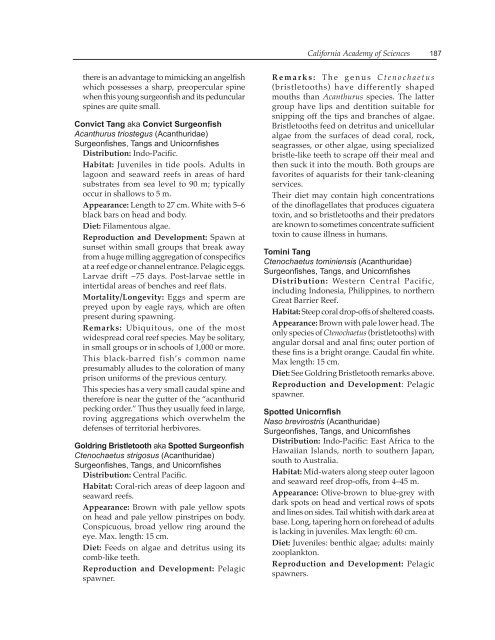THE STEINHART AQUARIUM - Gulf of Guinea Science ...
THE STEINHART AQUARIUM - Gulf of Guinea Science ...
THE STEINHART AQUARIUM - Gulf of Guinea Science ...
You also want an ePaper? Increase the reach of your titles
YUMPU automatically turns print PDFs into web optimized ePapers that Google loves.
there is an advantage to mimicking an angelfish<br />
which possesses a sharp, preopercular spine<br />
when this young surgeonfish and its peduncular<br />
spines are quite small.<br />
Convict Tang aka Convict Surgeonfish<br />
Acanthurus triostegus (Acanthuridae)<br />
Surgeonfishes, Tangs and Unicornfishes<br />
Distribution: Indo-Pacific.<br />
Habitat: Juveniles in tide pools. Adults in<br />
lagoon and seaward reefs in areas <strong>of</strong> hard<br />
substrates from sea level to 90 m; typically<br />
occur in shallows to 5 m.<br />
Appearance: Length to 27 cm. White with 5–6<br />
black bars on head and body.<br />
Diet: Filamentous algae.<br />
Reproduction and Development: Spawn at<br />
sunset within small groups that break away<br />
from a huge milling aggregation <strong>of</strong> conspecifics<br />
at a reef edge or channel entrance. Pelagic eggs.<br />
Larvae drift ~75 days. Post-larvae settle in<br />
intertidal areas <strong>of</strong> benches and reef flats.<br />
Mortality/Longevity: Eggs and sperm are<br />
preyed upon by eagle rays, which are <strong>of</strong>ten<br />
present during spawning.<br />
Remarks: Ubiquitous, one <strong>of</strong> the most<br />
widespread coral reef species. May be solitary,<br />
in small groups or in schools <strong>of</strong> 1,000 or more.<br />
This black-barred fish’s common name<br />
presumably alludes to the coloration <strong>of</strong> many<br />
prison uniforms <strong>of</strong> the previous century.<br />
This species has a very small caudal spine and<br />
therefore is near the gutter <strong>of</strong> the “acanthurid<br />
pecking order.” Thus they usually feed in large,<br />
roving aggregations which overwhelm the<br />
defenses <strong>of</strong> territorial herbivores.<br />
Goldring Bristletooth aka Spotted Surgeonfish<br />
Ctenochaetus strigosus (Acanthuridae)<br />
Surgeonfishes, Tangs, and Unicornfishes<br />
Distribution: Central Pacific.<br />
Habitat: Coral-rich areas <strong>of</strong> deep lagoon and<br />
seaward reefs.<br />
Appearance: Brown with pale yellow spots<br />
on head and pale yellow pinstripes on body.<br />
Conspicuous, broad yellow ring around the<br />
eye. Max. length: 15 cm.<br />
Diet: Feeds on algae and detritus using its<br />
comb-like teeth.<br />
Reproduction and Development: Pelagic<br />
spawner.<br />
California Academy <strong>of</strong> <strong>Science</strong>s<br />
R e m a r k s : T h e g e n u s C t e n o c h a e t u s<br />
(bristletooths) have differently shaped<br />
mouths than Acanthurus species. The latter<br />
group have lips and dentition suitable for<br />
snipping <strong>of</strong>f the tips and branches <strong>of</strong> algae.<br />
Bristletooths feed on detritus and unicellular<br />
algae from the surfaces <strong>of</strong> dead coral, rock,<br />
seagrasses, or other algae, using specialized<br />
bristle-like teeth to scrape <strong>of</strong>f their meal and<br />
then suck it into the mouth. Both groups are<br />
favorites <strong>of</strong> aquarists for their tank-cleaning<br />
services.<br />
Their diet may contain high concentrations<br />
<strong>of</strong> the din<strong>of</strong>lagellates that produces ciguatera<br />
toxin, and so bristletooths and their predators<br />
are known to sometimes concentrate sufficient<br />
toxin to cause illness in humans.<br />
Tomini Tang<br />
Ctenochaetus tominiensis (Acanthuridae)<br />
Surgeonfishes, Tangs, and Unicornfishes<br />
Distribution: Western Central Pacific,<br />
including Indonesia, Philippines, to northern<br />
Great Barrier Reef.<br />
Habitat: Steep coral drop-<strong>of</strong>fs <strong>of</strong> sheltered coasts.<br />
Appearance: Brown with pale lower head. The<br />
only species <strong>of</strong> Ctenochaetus (bristletooths) with<br />
angular dorsal and anal fins; outer portion <strong>of</strong><br />
these fins is a bright orange. Caudal fin white.<br />
Max length: 15 cm.<br />
Diet: See Goldring Bristletooth remarks above.<br />
Reproduction and Development: Pelagic<br />
spawner.<br />
Spotted Unicornfish<br />
Naso brevirostris (Acanthuridae)<br />
Surgeonfishes, Tangs, and Unicornfishes<br />
Distribution: Indo-Pacific: East Africa to the<br />
Hawaiian Islands, north to southern Japan,<br />
south to Australia.<br />
Habitat: Mid-waters along steep outer lagoon<br />
and seaward reef drop-<strong>of</strong>fs, from 4–45 m.<br />
Appearance: Olive-brown to blue-grey with<br />
dark spots on head and vertical rows <strong>of</strong> spots<br />
and lines on sides. Tail whitish with dark area at<br />
base. Long, tapering horn on forehead <strong>of</strong> adults<br />
is lacking in juveniles. Max length: 60 cm.<br />
Diet: Juveniles: benthic algae; adults: mainly<br />
zooplankton.<br />
Reproduction and Development: Pelagic<br />
spawners.<br />
187


